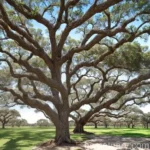Pin Oak (Quercus palustris) – The Ultimate Guide
As a plant scientist, I have always been fascinated by the pin oak tree (Quercus palustris). This magnificent tree is a valuable asset to any landscape, with its striking appearance and numerous ecological benefits. In this comprehensive guide, we will delve deep into the pin oak’s characteristics, cultivation, care, and ecological importance. Whether you are a homeowner, landscaper, or simply an enthusiast of nature, this guide will provide you with valuable insights into the world of pin oak trees.
What is the Pin Oak (Quercus palustris)?
The pin oak, scientifically known as Quercus palustris, is a species of oak native to North America. It is a member of the red oak group, characterized by its pointed lobes and bristled tips on its leaves. The species name “palustris” is derived from the Latin word for “marshy” or “swampy,” reflecting the tree’s natural habitat in wetland areas.
Key Takeaways – Pin Oak (Quercus palustris)
- Scientific Name: Quercus palustris
- Common Name: Pin Oak
- Family: Fagaceae
- Type: Deciduous Tree
- Native Habitat: North America
- USDA Hardiness Zones: 4-8
- Mature Height: 60-70 feet
- Mature Spread: 25-40 feet
- Growth Rate: Moderate to Fast
Pin Oak Facts
Before diving into the specifics of the pin oak’s culture and care, let’s explore some interesting facts about this remarkable tree.
- The pin oak is named for the small, slender twigs that look like pins.
- It is a popular choice in urban landscaping due to its adaptability to various soil and moisture conditions.
- The acorns produced by pin oaks serve as a valuable food source for wildlife, including birds and small mammals.
- In fall, the pin oak’s foliage turns a brilliant scarlet-red color, adding a stunning visual display to the landscape.
Pin Oak Description
The pin oak is known for its distinctive foliage, deeply lobed leaves, and a pyramidal or oval-shaped crown. Its leaves are glossy green in the summer and turn vibrant shades of red in the fall. Additionally, the tree’s bark is smooth and dark gray when young, developing ridges and furrows as it matures.
Pin Oak Leaves
The leaves of pin oak are the defining feature of this species. They are deeply lobed, with five to seven bristle-tipped lobes and a deep sinuses between lobes. During the growing season, the leaves are bright green, turning to red and bronze in the fall, providing a spectacular display of autumn colors.
Pin Oak Leaf Identification
When identifying pin oak leaves, look for the following characteristics:
- Deeply lobed with 5-7 bristle-tipped lobes
- Sinuses between lobes are deep and U-shaped
- Leaf size ranges from 3 to 6 inches in length and width
- Glossy, dark green in summer, turning red in the fall
Pin Oak Bark
Young pin oak trees have smooth, dark gray bark that becomes furrowed and scaly as they mature. The ridges and furrows develop in a diamond-like pattern, creating an aesthetically pleasing texture.
Pin Oak Uses
The pin oak serves various practical and ecological purposes, making it an invaluable addition to landscapes, woodlands, and wetland ecosystems.
Landscape Design
- Pin oaks are often used as shade trees in residential and urban landscapes due to their rapid growth and graceful form.
- The tree’s striking fall foliage adds visual interest to parks, golf courses, and large estates.
- Due to their adaptability, pin oaks are frequently planted along streets and in commercial developments.
Ecological Importance
- Pin oaks support a diverse array of wildlife by providing food and habitat for birds, squirrels, and other small animals.
- Their extensive root systems contribute to soil stabilization and erosion control, especially in wetland areas.
- The species has an important role in carbon sequestration, helping mitigate the effects of climate change.
Uses in Construction
- While not as widely used in construction as other oak species, pin oak timber is utilized for cabinets, furniture, and interior finishing due to its attractive grain pattern.
Pin Oak Habitat
The pin oak is indigenous to the eastern United States, where it thrives in a range of moist, acidic soils. It is commonly found in bottomland forests, floodplains, and along stream banks.
Wetland Environments
Pin oaks are well-adapted to wetland conditions and are often part of the riparian ecosystems. They provide vital ecological services in these environments, helping to maintain water quality and prevent erosion.
Pin Oak Growth
When properly cared for, pin oaks exhibit vigorous growth, making them a preferred choice for establishing tree cover in a short amount of time. Young trees may have a more pyramidal shape, but they develop a broad, spreading crown with age.
Pin Oak Characteristics
Several key characteristics define the pin oak tree and set it apart from other species of oak.
- Distinctive foliage with deeply lobed leaves and bristle-tipped lobes
- Moderate to fast growth rate, particularly in well-drained, fertile soils
- High tolerance for wet soils and periodic flooding
- Brilliant red fall foliage, making it a standout in autumn landscapes
- Suitable for urban and suburban environments due to adaptability and pollution tolerance
Pin Oak Diseases
While pin oaks are generally robust, they are susceptible to certain diseases, particularly those that affect other members of the red oak group.
Common Diseases
- Oak Wilt: A fungal disease that causes wilting and eventual death of the tree. It is spread by sap-feeding beetles and root grafts between trees.
- Anthracnose: A fungal disease that leads to leaf browning, wilting, and premature defoliation, particularly in cool, wet spring conditions.
- Powdery Mildew: A cosmetic disease that affects the appearance of the foliage but typically does not cause severe harm to the tree.
Disease Diagnosis
Diagnosing diseases in pin oak trees requires careful observation of symptoms such as wilting, discoloration, and premature leaf drop. Consultation with a certified arborist or plant pathologist may be necessary to accurately identify and address any disease issues.
Pin Oak Care
Proper care is essential for maintaining the health and vitality of pin oak trees, especially in urban and suburban settings where they face various environmental stressors.
Water
- Young Trees: Water regularly, especially during the first few years after planting, to help establish a deep, robust root system.
- Mature Trees: In most cases, pin oaks can withstand periodic periods of drought, but they may require supplemental irrigation during prolonged dry spells.
Sunlight
Pin oaks thrive in full sun to partial shade. It is essential to provide adequate sunlight, especially in the northern regions, to ensure optimal growth and foliage density.
Fertilizer
- Young Trees: Apply a balanced, slow-release fertilizer in spring to promote healthy growth and establishment.
- Mature Trees: Fertilization may be necessary in nutrient-poor soils or under conditions of sustained stress, but it should be done sparingly to avoid excessive nutrient accumulation.
Soil
- Pin oaks prefer acidic, well-drained soil, but they are adaptable to a wide range of soil types, including loam and clay.
- Mulching with organic materials can aid in moisture retention and improve soil structure around the root zone.
Pruning
- Prune pin oak trees during the dormant season to remove dead or crossing branches and to shape the canopy for structural integrity.
- Avoid heavy pruning during the growing season, as this can stress the tree and make it susceptible to diseases and pests.
Pin Oak Propagation
Propagation of pin oak trees is primarily achieved through seeds, although it can also be performed through hardwood cuttings or grafting for specific cultivars.
Seed Propagation
- Collect acorns in the fall when they are mature and sow them immediately or store them at cool temperatures until spring.
- Germination can be uneven and may take several months, but the resulting seedlings are generally robust and adaptable.
Hardwood Cuttings
While less common, hardwood cuttings can be taken from mature trees in late winter and rooted to produce new plants. This method is more challenging and often requires specific environmental conditions to succeed.
Pin Oak in Containers
While planting pin oaks in containers is less common due to their large size and extensive root systems, it is possible for a limited period when the trees are young.
Container Popularity
- Pin oak trees are not typically grown in containers due to their rapid growth and ultimate size, which may surpass the limitations of most containers.
- Container cultivation is more suitable for temporary staging or for the convenience of relocating young trees to larger growing spaces.
Common Pests
Although pin oaks are relatively pest-resistant, they may encounter certain insect pests that can impact their health and vigor.
Common Insect Pests
- Gypsy Moth: The larvae of this moth species can defoliate trees if left unchecked, particularly during outbreaks.
- Oak Sawfly: The larvae of sawflies feed on oak foliage, causing cosmetic damage but rarely threatening the long-term health of the tree.
Botanist’s Tips
As a plant scientist with expertise in oak species, here are some valuable tips for cultivating and caring for pin oak trees.
- Soil Testing: Periodic soil testing helps to evaluate the nutrient status and pH levels of the soil, allowing for targeted fertilizer applications.
- Mulching: Use organic mulch around the base of the tree to conserve soil moisture, moderate soil temperature, and suppress competing vegetation.
- Integrated Pest Management: Monitor trees regularly for signs of pests and diseases, and employ cultural and biological control methods as the first line of defense.
Fun Facts
- The pin oak is frequently used as a bonsai subject due to its adaptability to container culture and its fine branching structure.
- In the past, Native American tribes used various parts of the pin oak for medicinal purposes, including treating fever and dysentery.
Links to External Resources
For additional information about pin oak trees and related topics, I encourage you to explore the following resources:
- The Morton Arboretum – Pin Oak
- USDA Forest Service – Quercus palustris Fact Sheet
- Arbor Day Foundation – Pin Oak
In conclusion, the pin oak (Quercus palustris) stands as a symbol of resilience, adaptability, and natural beauty. Whether providing shade in an urban park, enriching wetland ecosystems, or gracing suburban landscapes with its vibrant fall colors, the pin oak is a testament to the enduring impact of native trees in our world.
As stewards of the environment, we can cultivate and care for pin oak trees to ensure their continued presence and contribution to the ecological balance of our surroundings. Through understanding and appreciating the unique characteristics and benefits of the pin oak, we take a step closer to nurturing a harmonious relationship with nature and fostering sustainable landscapes for generations to come.















